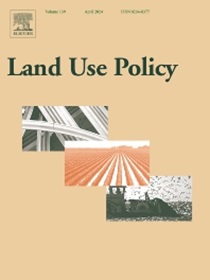Decoding the formation mechanisms of rural settlements expansion patterns in transitional China
IF 5.9
1区 社会学
Q1 ENVIRONMENTAL STUDIES
引用次数: 0
Abstract
In recent decades, the rural settlements (RSs) in China have experienced a remarkable process of differentiation and restructuring during the stages of urban expansion, urban transformation, and coordinated urban-rural development. As an important part of urban-rural integrated development, the quantitative transformation and landscape dynamics of RSs are crucial for optimizing RSs and implementing the national rural revitalization strategy. However, there is still a lack of research on the characteristics and evolutionary mechanisms of landscape patterns of RSs in China. To fill the gap, this study employed land use datasets from 1980 to 2020 to investigate the formation mechanisms of the landscape pattern for RSs in China, utilizing multiple statistical analysis models. The findings revealed a gradual increase in RSs, predominantly resulting from the conversion of cultivated land. During the study period, the overall landscape pattern indices for RSs exhibited an overall increasing trend. The regions exhibiting the high values of patch density and percentage of landscape were predominantly situated within the Huang-Huai-Hai plain. The regions exhibiting the high values of the landscape shape index were primarily concentrated in the Huang-Huai-Hai plain and the Northeast China plain. The counties exhibiting a low agglomeration index were predominantly situated in the middle-lower Yangtze plain. Hotspot analysis revealed that RSs in Huang-Huai-Hai plain exhibited a more pronounced trend of fragmentation during the study period. The Geodetector model revealed that nighttime lighting, land use intensity, slope, elevation, population density, and precipitation were the determining factors in the formation of RSs. Geographically weighted regression model demonstrated significant spatial heterogeneity in the effects of these factors. This study contributed to the formulation of settlement development strategies, the optimization of RSs layouts, and the promotion of rural revitalization.
解读转型期中国农村聚落扩张模式的形成机制
近几十年来,中国农村聚落在城市扩张、城市转型和城乡协调发展阶段经历了显著的分化和重构过程。乡村乡村作为城乡融合发展的重要组成部分,其数量转化和景观动态对于优化乡村乡村、实施国家乡村振兴战略至关重要。然而,对中国RSs景观格局的特征及其演化机制的研究还比较缺乏。为了填补这一空白,本研究利用1980 - 2020年的土地利用数据,利用多种统计分析模型,对中国RSs景观格局的形成机制进行了研究。调查结果显示,相对过饱和度逐渐增加,主要是由于耕地的转换。研究期间,各景观格局指数总体呈上升趋势。斑块密度和景观百分比高的区域主要分布在黄淮海平原。景观形态指数高的区域主要集中在黄淮海平原和东北平原。集聚指数低的县域主要分布在长江中下游平原。热点分析表明,黄淮海平原RSs破碎化趋势更为明显。Geodetector模型显示,夜间照明、土地利用强度、坡度、海拔、人口密度和降水是RSs形成的决定因素。地理加权回归模型显示,这些因素的影响具有显著的空间异质性。该研究有助于制定聚落发展战略,优化RSs布局,促进乡村振兴。
本文章由计算机程序翻译,如有差异,请以英文原文为准。
求助全文
约1分钟内获得全文
求助全文
来源期刊

Land Use Policy
ENVIRONMENTAL STUDIES-
CiteScore
13.70
自引率
8.50%
发文量
553
期刊介绍:
Land Use Policy is an international and interdisciplinary journal concerned with the social, economic, political, legal, physical and planning aspects of urban and rural land use.
Land Use Policy examines issues in geography, agriculture, forestry, irrigation, environmental conservation, housing, urban development and transport in both developed and developing countries through major refereed articles and shorter viewpoint pieces.
 求助内容:
求助内容: 应助结果提醒方式:
应助结果提醒方式:


